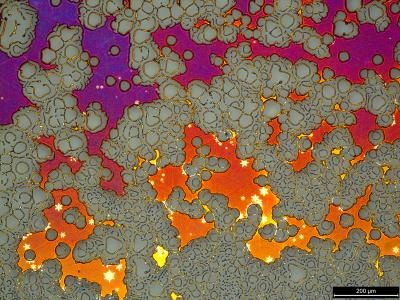Nano-designed transistors with disordered materials, but high performance
The Holy Grail for transistor designers has been the requirement to be able to get high performance at reduced costs over very large substrate areas. Transistors on cheap and flexible substrates like glass and plastics are currently unable to deliver such performance and therefore do not lend themselves to seamless monolithic integration of increased electronic functions on human interface devices (displays and sensors).
At present, high performance transistors are only available in crystalline materials which are expensive and have to be attached ex-situ onto larger area substrates, which adds to the expense and complexity of system design. If both the electronics and display substrates can be integrated onto one platform, it would usher a new dawn in immersive and personal electronics. Individuals will thus be able to communicate, send and receive information of value, and access data about their current environment and health status with freedom, at leisure, and in comfort. However, in general, the deposition of semiconductor films used to make transistors on such substrates has to be carried out at low temperatures to preserve substrate integrity. As a result, the quality of the organic or inorganic semiconductor films is severely constrained, and has a dramatic influence on the transistor performance.
In a recent report to be published in Science - 'Engineering Perspectives', backed by a further paper to appear in IEEE Electron Device Letters, engineers propose the use of clever transistor structure designs to overcome some of the issues with obtaining suitably low power and high speed operations in standard material systems. In the first collaborative work with Hitachi Central Research Laboratory, Japan, researchers at the Advanced Technology Institute of the University of Surrey have experimentally and theoretically demonstrated that for transistors of disordered silicon films, superior switching performance (low leakage current, and steep sub-threshold slope) can be achieved by making the conduction channel in the transistor very thin. A higher ION/IOFF ratio, which exceeds 1011, can be achieved for devices with a 2.0-nm-thick channel. Another seminal work from the same research laboratory at Surrey, is on the newly developed source-gated transistor (SGT) concept by Professor John Shannon. Compared to a field-effect transistor, the SGTs can operate with very short source-drain separations even with a thick gate insulator layer to achieve high speed, good stability and superior control of current uniformity, providing a significant advantage in terms of the fabrication process.
Dr Xiaojun Guo, one of the lead investigators, comments: "Engineering of the transistor structure itself rather than the channel material can lead to improved device performance. It will enable the design of high-performance large area circuits and systems based on low-cost reliable material processes".
Original publications: X. Guo and S.R.P. Silva, 'High-Performance Transistors by Design', Science 2008, vol 320.
X. Guo, T. Ishii, and S.R.P. Silva, 'Improving Switching Performance of Thin-Film Transistors in Disordered Silicon', IEEE Electron Device Letters 2008, vol 29 Issue 6.
Other news from the department science
These products might interest you
Most read news
More news from our other portals
See the theme worlds for related content
Topic world Sensor technology
Sensor technology has revolutionized the chemical industry by providing accurate, timely and reliable data across a wide range of processes. From monitoring critical parameters in production lines to early detection of potential malfunctions or hazards, sensors are the silent sentinels that ensure quality, efficiency and safety.

Topic world Sensor technology
Sensor technology has revolutionized the chemical industry by providing accurate, timely and reliable data across a wide range of processes. From monitoring critical parameters in production lines to early detection of potential malfunctions or hazards, sensors are the silent sentinels that ensure quality, efficiency and safety.
































































